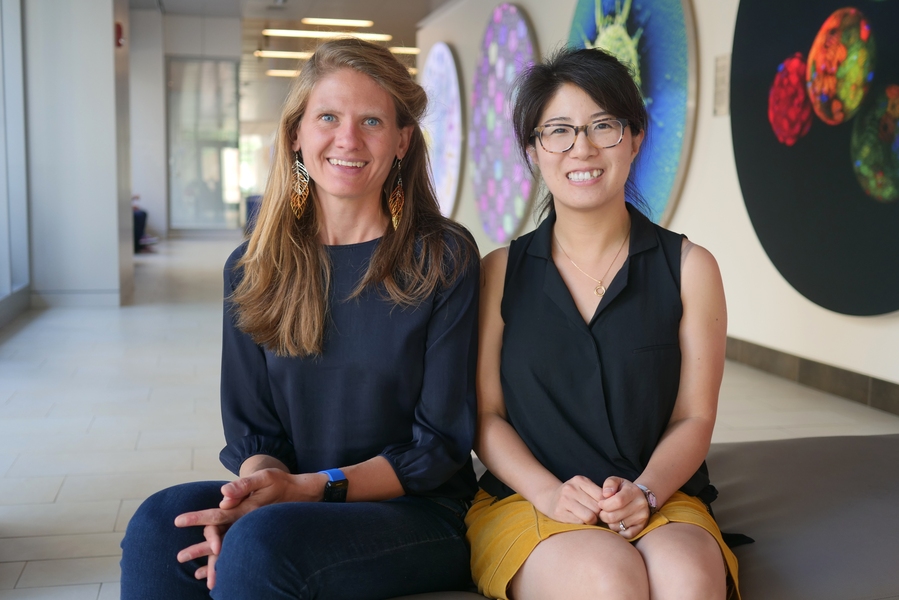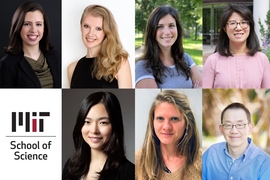MIT’s Department of Biology welcomed two new assistant professors in recent months: Pulin Li began at the Whitehead Institute in May, and Seychelle Vos arrived at Building 68 in September. Their respective expertise in genetic circuits and genome organization will augment the department’s efforts to explore cell biology at all levels — from intricate molecular structures to the basis for human disease.
“Pulin and Seychelle bring new perspectives and exciting ideas to our research community,” says Alan Grossman, department head. “I’m excited to see them start their independent research programs and look forward to the impact that they will have."
From cells to tissues
Growing up in Yingkou, China, Li was exposed to science at a young age. Her dad worked for a pharmaceutical company researching traditional Chinese medicine, and Li would spend hours playing with his lab tools and beakers. “I can still vividly remember the smell of his Chinese herbs,” she says. “Maybe that’s part of the reason why I’ve always been interested in biology as it relates to medical sciences.”
She earned her BS in life sciences from Peking University, and went on to pursue a PhD in chemical biology at Harvard University studying hematopoietic stem cells. Li performed chemical screens to find drugs that would make stem cell transplantation in animal models more efficient, and eventually help patients with leukemia. In doing so, she became captivated by the molecular mechanisms that control cell-to-cell communication.
“I would like to eventually go back to developing new therapies and medicines,” she says, “but that translational research requires a basic understanding of how things work at a molecular level.”
As a result, her postdoc at Caltech was firmly rooted in basic biology. She investigated the genetic circuits that underlie cell-cell communication in developing and regenerating tissues, and now aims to develop new methods to study these same processes here at MIT.
Traditional genetic approaches involve breaking components of a system one at a time to investigate the role they play. However, Li’s lab will adopt a “bottom-up” approach that involves building these systems from the ground up, adding the components back into the cell one by one to pinpoint which genetic circuits are sufficient for programming tissue function. “Building up a system, rather than tearing it down, allows you to test different circuit designs, tune important parameters, and understand why a circuit has evolved to perform a specific function,” she explains.
She is most interested in determining which aspects of cellular communication are critical for tissue formation, in hopes of understanding the diversity of life forms in nature, as well as inspiring new methods to engineer or regenerate different tissues.
“My dream would be to put a bunch of genetic circuits into cells in such a way that they could enable the cells to self-organize into certain patterns and shapes, and replace damaged tissues in a patient,” she says.
Proteins that organize DNA
Although Vos was born in South Africa, her family moved so frequently for her father’s job that she doesn’t call any one place home. “If I had to pick, I’d say it would be the middle of the Atlantic Ocean,” she says.
Both of her grandparents on her mother’s side were researchers, and encouraged various scientific escapades, like bringing wolf spiders to kindergarten for show-and-tell. Her grandmother on her father’s side found her early passions “mildly disturbing,” but dutifully fulfilled her requests for high-resolution insect microscopy books nonetheless.
“I really wanted to know how plants and animals worked starting from a young age, thanks to my grandparents,” Vos says.
In high school she was already conducting research on the side at Clemson University, South Carolina, and went on to earn her BS in genetics from the University of Georgia. She began her PhD in molecular cell biology at the University of California at Berkeley intending to study immunology, but surprised herself by becoming taken with structural biology instead.
Purifying proteins and solving structures required a much different skill set than performing screens and manipulating genomes, but she very much enjoyed her work on topoisomerase, the enzyme that modifies DNA so it doesn’t become too coiled.
She continued conducting biochemical and structural research during her postdoc at the Max Planck Institute for Biophysical Chemistry in Germany. There, she used cryogenic electron microscopy to probe how different RNA polymerase II complexes are regulated during transcription in eukaryotes.
Today, she’s a molecular biologist at her core, but she’s prepared to use “whatever technique gets the answer.” As she explains: “You need biochemistry to solve structures and genetics to understand how they’re working within the whole organism, so it's all related.”
In her new lab in Building 68, she will continue investigating gene expression, but this time in the context of genome organization. DNA must be compacted in order to fit into a cell, and Vos will study the proteins that organize DNA so it can be compressed without interfering with gene expression. She also wants to know how those same proteins are affected by gene expression.
“How gene regulation impacts compaction is a really critical question to address because different cell types are organized in different ways, and that impacts which genes are ultimately expressed,” she says. “We still don’t really understand how these processes work at an atomic level, so that’s where my expertise in biochemistry and structural biology can be useful.”
When asked what they are most excited about as the school year begins, both Li and Vos say the same thing: the diverse skills and expertise of the students and faculty.
“It's not just about solving one structure, people here want to understand the entire process,” Vos says. “Biology is a conglomeration of many different fields, and if we can have engineers, mathematicians, physicists, chemists, biologists, and others work together, we can begin to tackle pressing questions.”







